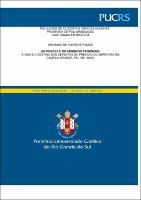| Share record |


|
Please use this identifier to cite or link to this item:
https://tede2.pucrs.br/tede2/handle/tede/8753| Document type: | Tese |
| Title: | As prisões e os arquivos prisionais : a vida e o destino dos detentos do presídio do Serrotão em Campina Grande, PB (1991-2012) |
| Author: | Ramos , Helmano de Andrade  |
| Advisor: | Martins, Luis Carlos dos Passos |
| Abstract (native): | O objetivo é conhecer a vida e o destino de alguns dos detentos do Presídio do Serrotão, a partir da documentação que lhes dá sentido. Para tanto, fizemos em um breve histórico sobre as reformas carcerárias para o interior do nordeste, contida nas três formas de prisões modernas existentes no Brasil: a Casa de Correção, a Casa de Detenção e as Colônias Agrícolas. Delas, a mais antiga, as Casas de Correção foram projetadas como monumentos das capitais da República, com estrutura Panóptica e sistema Auburn de funcionamento. Dentro delas, mais que os estudos antropométricos para o entendimento do crime e da criminalidade, acabaram reforçando os traços patriarcais e escravistas que marcam a sociedade canavieira de Salvador e Recife. Que, no entanto, interiorizou-se na Região Nordeste, na forma da Casa de Detenção, com estrutura celular e sistema Auburn ou Pensilvânia de funcionamento, enquanto as identidades criminosas foram ampliadas pelo código criminal de 1830 e os códigos municipais de postura. Com isso, a identidade dos criminosos denunciados pelos advogados que tinham a profissão de jornalistas era diferente do que imaginavam às metrópoles. Na Cidade da Parahyba, a Cadeia Velha foi substituída por uma prisão, que deu nome a um bairro de João Pessoa, Roger. Em Campina Grande, a Casa de Detenção é a referência do bairro Monte Santo. Finalmente, de todos os modelos pensados para as regiões menos industrializadas, as Colônias Agrícolas difundidas em toda a América Latina trazemuma documentação que pretendemos recompor, através do arquivo-morto do Presídio Regional Agrícola de Campina Grande, Presídio do Serrotão, para que dessas conexões, surja a vida e o destino dos detentos: foragidos, falecidos, transferidos e soltos do presídio. E, diante de todos esses, aqueles que se destacaram pela relação entre a sua vida privada e o crime, por sua condição socioeconômica e/ou posição político-social envolvidas nos crimes e nas formas que se utilizaram para serem soltos do presídio. |
| Abstract (english): | The objective of this work is to understand the life and destiny of inmates of the Prison of Serrotão by analyzing the documentation that gives them meaning. For such, we have studied the history of prison reforms in the Brazilian northeast, including the three modern forms of prisons in the Country: the Correctional House, the House of Detention and the Agricultural Colonies. The Correctional Houses, older than the other two types of prisons, were designed as monuments for the capitals of the republic, with a Panoptic structure and operating the Auburn system. More than anthropometric studies for the understanding of crime and criminality, they reinforce the patriarchal and slavery features that characterize the sugarcane society of Salvador and Recife. In the countryside, this model is nevertheless converted into the House of Detention, with cellular structure and operating either the Auburn or the Pennsylvania system. The criminal identities were amplified by the criminal code of 1830 and the municipal codes of posture. Hence, the identities of the criminals, denounced by lawyers that also worked as journalists, were different from what they imagined in the metropolis. In the City of Parahyba, the Old Jail (Cadeia Velha) was replaced with a prison, which ended up inspiring the name to a neighborhood of João Pessoa, Roger. In Campina Grande, the Detention House is considered a landmark of the Monte Santo neighborhood. Finally, of all the models imagined for the less industrialized regions of the world, the Agricultural Colonies spread throughout Latin America offer a historical documentation that we intend to recompose through the dead file of the Local Agricultural Prison of Campina Grande (Presídio Regional Agrícola de Campina Grande), Prison of Serrotão, and through these connections the life and destiny of the inmates: the runaways, deceased, transferred and released from prison, including those who stood out for their private life and crime relationship, for their socioeconomic and/or sociopolitical condition, and for the means that they employed in order to released from prison. |
| Keywords: | Prisões Presos Arquivos prisionais |
| CNPQ Knowledge Areas: | CIENCIAS HUMANAS::HISTORIA |
| Language: | por |
| Country: | Brasil |
| Publisher: | Pontifícia Universidade Católica do Rio Grande do Sul |
| Institution Acronym: | PUCRS |
| Department: | Escola de Humanidades |
| Program: | Programa de Pós-Graduação em História |
| Access type: | Acesso Aberto |
| Fulltext access restriction: | Trabalho não apresenta restrição para publicação |
| URI: | http://tede2.pucrs.br/tede2/handle/tede/8753 |
| Issue Date: | 22-Mar-2019 |
| Appears in Collections: | Programa de Pós-Graduação em História |
Files in This Item:
| File | Description | Size | Format | |
|---|---|---|---|---|
| Texto Final-tese 22.05.2019.pdf | HELMANO_DE_ANDRADE_RAMOS_TES | 1.96 MB | Adobe PDF |  Download/Open Preview |
Items in DSpace are protected by copyright, with all rights reserved, unless otherwise indicated.




